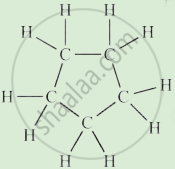Advertisements
Advertisements
प्रश्न
Out of KCl, HCl, CCl4 and NaCl, the compounds which are not ionic are:
(a) KCl and HCl
(b) HCl and CCl4
(c) CCl4 and NaCl
(d) KCl and CCl4
उत्तर
(b) HCl and CCl4
Both these compounds are formed by sharing of electrons and hence, they form covalent bonds and not ionic bonds.
APPEARS IN
संबंधित प्रश्न
What are covalent compounds?
Write any three features and give two examples of covalent compounds
What type of bonds are present in water molecule? Draw the electron-dot structure of water (H2O).
Fill in the blank in the following sentence:
The number of single covalent bonds in C2H2 molecule are ...........
Give the formula of the compound that would be formed by the combination of the following pair of elements:
K and H
The molecules having triple bond in them are:
(a) oxygen and ethyne
(b) carbon dioxide and ammonia
(c) methane and ethene
(d) nitrogen and ethyne
One of the following is not an allotrope of carbon. This is:
(a) diamond
(b) graphite
(c) cumene
(d) buckministerfullerene
What are the conditions necessary for the formation of covalent molecules?
Complete the following:
In case of non-polar covalent bond, the covalent bond is formed in the ______ of atoms and shared electrons are ______ distributed. (corner, middle, equally, unequally)
Give two example in following case:
Liquid non polar compounds
Explain the Structural isomerism term with example.
Molecular formula of Propane is C3H8 , write the structural formula of propane.
Give examples for the following:
Two gaseous non polar compounds.
Explain the following:
Covalent compounds have low melting and boiling point.
(a) Compound X consists of molecules.
Choose the letter corresponding to the correct answer from the choices (a), (b), (c) and (d) given below
X is likely to have a :
An element L consists of molecules.
Why L is heated with iron metal, it forms a compound FeL. What chemical term would you use to describe the change undergone by L?
Define the functional group and complete the following table.
| S.I. No. | Functional Group | Compound | Formula |
| (1) | ______________ | _______________ |
C2H5OH |
| (2) | _______________ | _______________ | CH3CHO |
Write scientific reason.
Carbon has the property of forming many compounds.
Complete the following activity.
Write the names of the hydrocarbons for the following structural formula.
(isobutylene, cyclohexane, propene, cyclohexene, cyclopentane, benzene, propyne, isobutane, propane)
 |
